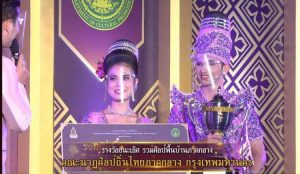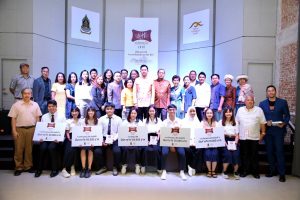ลูกชิด : ผลผลิตจากต้นตาว
ผศ.วิชัย ปทุมชาติพัฒน์
ความนำ
“ลูกชิด” เป็นของกินคู่กับน้ำแข็งไสและไอศกรีมเป็นที่รู้จักดีกันของทุกคนทุกเพศทุกวัย แต่มีน้อยคนที่จะรู้จักที่มาของมัน คนในหลายท้องถิ่นเช่นคนในภาคตะวันเฉียงเหนือจะเรียกลูกชิดว่า “ลูกจาก” ก็เรียกต่อๆกันมาหลายชั่วอายุโดยไม่มีการปรับเปลี่ยนหรือแก้ไข อาจจะไม่ทราบว่าลูกชิดกับลูกจากนั้นมีที่มาจากคนละต้นกัน ลูกชิดได้มาจากต้นตาว ส่วนลูกจากได้มาจากต้นจาก หน้าตาก็แตกต่างกันมาก แม้รสชาติจะคล้ายกัน อย่างไรก็ตามพืชทั้งสองชนิดนี้ต่างก็อยู่ในวงศ์เดียวกัน คือวงศ์มะพร้าว หรือ PALMAE นั่นเอง บทความนี้มุ่งให้ความรู้เรื่อง“ต้นตาว”ที่มาของลูกชิดและประโยชน์หลายประการของต้นตาวและลูกชิด ซึ่งมีอีกหลายชื่อ เช่น ลูกตาว ลูกต๋าว ลูกเหนา ลูกชก และส่งเสริมให้ช่วยกันปลูกเพื่อการอนุรักษ์ เนื่องจากในปัจจุบันมีจำนวนต้นตาวลดน้อยลงอย่างมาก สาเหตุมาจากการที่ป่าถูกทำลายอย่างต่อเนื่องและไม่มีการปลูกเพื่อทดแทน ต้นที่ตายไป ต้นตาวจึงมีโอกาสสูญพันธุ์ เพราะต้นตาวสามารถออกดอกติดผลได้เพียงครั้งเดียวในชีวิตประมาณ4-5 ปีแล้วก็จะยืนต้นตาย การปลูกทดแทนจะต้องใช้เวลาประมาณ 8-12 ปีตั้งแต่เริ่มปลูกจึงจะออกดอกติดผลครั้งเดียวดังได้กล่าวไว้
ตาว
ชื่อสามัญ Sugar palm, Aren, Arenga palm, Black-fiber palm, Gomuti palm, Kaong, Irok
ชื่อวิทยาศาสตร์ Arenga pinnata (Wurmb) Merr.
ชื่อวงศ์ ARECACEAE ชื่อเดิม PALMAE
ชื่ออื่นๆ ชิด ต๋าว มะต๋าว ฉก ชก ต้นชก เต่าเกียด
การกระจายพันธุ์ มีถิ่นกำเนิดและการกระจายพันธุ์อยู่ในเอเชียตะวันออกเฉียงใต้ ได้แก่ ประเทศไทย มาเลเซีย ฟิลิปปินส์ พม่า ลาว อินโดนีเซีย และอินเดีย สำหรับในประเทศไทยนั้นจะพบขึ้นตามป่าในเขตจังหวัดภาคเหนือเป็นหลัก เช่น น่าน พิษณุโลก อุตรดิตถ์ แพร่ และตาก ส่วนจังหวัดในภาคตะวันตกและภาคใต้นั้นพอมีบ้างแต่ไม่หนาแน่น ในปัจจุบันมีจำนวนต้นตาวลดน้อยลงอย่างมาก สาเหตุมาจากการที่ป่าถูกทำลายและไม่มีการปลูกเพื่อทดแทน
ลักษณะทางพฤกษศาสตร์ เป็นปาล์มแบบต้นเดี่ยวที่มีอายุยืนลักษณะคล้ายต้นตาล ลำต้นตรงสูงชะลูด มีหลายขนาด มีความสูงประมาณ 15-20 เมตร เส้นผ่านศูนย์กลางต้นราว 35-65 ซม. ใบประกอบแบบขนนกออกเรียงสลับกันบนทาง แต่ละทางมีความยาวประมาณ 6-10 เมตร ทางใบยาวประมาณ 6-10 เมตร ประมาณ 50 ทางต่อต้น มีใบย่อยประมาณ 80-130 ใบต่อทาง ใบมีลักษณะเช่นเดียวกับใบมะพร้าว แต่จะใหญ่และแข็งกว่า ใบเป็นรูปขอบขนาน ปลายใบมนและแหลม ส่วนโคนใบเป็นรูปเงี่ยงใบหอก ขอบเรียบ ผิวหนา หลังใบเป็นสีเขียวเข้มมันวาว ส่วนใต้ใบมีสีขาวนวล เมื่อใบแก่จะห้อยจนปิดคลุมลำต้น มีระบบรากฝอยเหมือนพืชวงศ์ปาล์ม ดอกออกเป็นช่อเชิงลดขนาดใหญ่ โดยดอกจะมีทั้งดอกเพศผู้และดอกสมบูรณ์เพศอยู่บนต้นเดียวกันแต่อยู่คนละช่อดอก โดยช่อดอกเพศผู้จะยาวประมาณ 1-2 เมตร ส่วนช่อดอกสมบูรณ์เพศจะยาวกกว่าช่อดอกเพศผู้ ออกดอกตามซอกใบ ห้อยยาวลงได้มากกว่า 2 เมตร ตั้งแต่ออกดอกจนเป็นผลสุกแก่จนร่วงหล่น อาจจะใช้เวลาประมาณ 2-3 ปี ดอกมีสีขาวขุ่น ผลเป็นกลุ่มเบียดติดแน่นบนทะลาย ผลเป็นรูปไข่สีเขียว มีขนาดประมาณ 3-4 ซม. เมื่อแก่จะเปลี่ยนเป็นสีม่วงเข้มจนถึงสีดำ ส่วนเมล็ดมีสีขาวขุ่น มีลักษณะนิ่มและอ่อน มี 2-3 เมล็ด เมล็ดอ่อนมีสีขาว ส่วนเมล็ดแก่มีสีดำ เปลือกของเมล็ดจะกลายเป็นกะลาบาง ๆ แข็ง ๆ มีสีดำ ส่วนเนื้อในของเมล็ดก็คือ “ลูกชิด” โดยต้นตาวจะให้ผลในช่วงอายุ 8-12 ปี
ข้อควรระวัง ผลตาวมีน้ำยาง ถ้าถูกผิวหนังจะคัน การเก็บผลออกจากทะลายจะต้องระมัดระวังเป็นพิเศษ ควรสวมเสื้อแขนยาวหรือสวมเสื้อผ้าให้มิดชิดใส่ถุงมือใส่แว่นกันน้ำยางเข้าตา
การเก็บผลตาว จะเริ่มตั้งแต่ปลายเดือนกันยายนถึงเดือนมีนาคม ให้ตัดเฉพาะทะลายที่แก่ ไม่โค่นทั้งต้น การเก็บแต่ละครั้งผู้เก็บต้องไปนอนค้างแรมอยู่ในป่าอย่างน้อย 2-3 คืน ในช่วงที่ฝนหยุดตก ส่วนในช่วงที่มีฝนจะหยุดการดำเนินการ เพราะไม่มีฟืนใช้ต้มลูกตาว เมื่อผลตาวต้มพอสุกแล้ว ก็ตัดขั้วผลแล้วหนีบเมล็ดออกโดยใช้เครื่องมือผลิตเองที่มีคันยกเพื่อออกแรงกดลงให้เมล็ดหลุดออกมา นำเมล็ดไปล้างน้ำให้สะอาดนำไปขายให้พ่อค้าคนกลางไปส่งโรงงานลูกชิดหรือนำมาต้มสุกหรือเชื่อมรับประทานได้
การส่งเสริมการอนุรักษ์พันธุ์ตาว
ต้นตาว ต้องใช้เวลาประมาณ 8-12 ปี จึงจะเริ่มออกดอกที่มีเกสรดอกแรก จากนั้นจึงเริ่มออกงวงและติดผล การออกงวงและติดผลของตาวนั้น จะเริ่มออกจากส่วนบนของต้น คือ บริเวณใต้ก้านทางหรือก้านล่างสุด โดยจะทยอยออกงวงรอบคอต้น ตาวหนึ่งต้นจะใช้เวลาออกงวงทั้งหมดประมาณ 2-3 ปี นับตั้งแต่งวงแรกที่อยู่ส่วนบนของต้น ไล่ลงมาจนโคนต้นด้านล่างที่ติดกับพื้นดิน เมื่อถึงงวงสุดท้าย ชีวิตของตาวก็จะจบลงไปเช่นเดียวกัน ดังนั้นชีวิตของตาวต้นหนึ่งจึงจะมีอายุอยู่ในช่วงระหว่าง 8-12 ปี ขึ้นอยู่กับว่าตาวต้นนั้นจะเริ่มออกงวงแรกเมื่อใด เมื่อออกงวงแรกแล้วอีก 4-5 ปี ตาวต้นนั้นก็จะตายจากไป
จะเห็นว่าต้นตาวสามารถออกดอกติดผลได้เพียงครั้งเดียวก็จะตายการปลูกทดแทนจะใช้เวลาตั้งแต่เริ่มปลูกจนออกดอกประมาณ 8-12 ปี ฉะนั้นจึงควรหันมาช่วยกันปลูกต้นตาวเสริมไว้ได้ตลอดเวลา ไม่ต้องรอให้ต้นแก่ตายไปก่อนแล้วจึงปลูก สำหรับต้นพันธุ์ตาวเพื่อนำมาปลูกนั้นสามารถขอคำปรึกษาได้จากสำนักงานเกษตรจังหวัดที่ระบุไว้ข้างบนได้
ประโยชน์ของตาว
1. เนื้อในเมล็ดผลตาว เรียกว่า ลูกชิดกินได้สดๆ หรืออาจนำไปเชื่อมน้ำตาล เพื่อให้ได้รสอร่อยขึ้นสามารถนำมาแปรรูปทำเป็นลูกชิดแช่อิ่ม ลูกชิดปี๊บ ลูกชิดกระป๋อง ลูกชิดอบแห้ง ซึ่งนำไปทำขนมได้หลายชนิด เช่น ใส่ในไอศกรีม หวานเย็น น้ำแข็งไส รวมมิตร ส่วนแหล่งผลิตลูกชิดที่สำคัญตั้งอยู่ที่จังหวัดน่าน ซึ่งเป็นโรงงานแปรรูปลูกชิตแห่งเดียวในเขตพื้นที่ภาคเหนือ
2. หน่ออ่อนและเนื้อข้างในลำต้นก็สามารถนำมาใช้ประกอบอาหารเช่นการทำเป็นแกงหรือใส่ข้าวเบือน เป็นต้น
3. ใบใช้มุงหลังคากั้นฝาบ้าน ก้านใบนำมาเหลารวมทำไม้กวาด เส้นใยที่ลำต้นใช้ทำแปรง
4. งวงตาวหรือดอกตาวสามารถนำมาใช้ทำเป็นน้ำตาลคล้ายกับน้ำตาลโตนดได้ ก้านช่อดอกมีน้ำหวาน อาจนำมาใช้ทำเป็นไวน์ผลไม้หรือน้ำส้มได้
5. ลำต้นสามารถนำมาใช้ทำเป็นเฟอร์นิเจอร์หรือใช้ทำเป็นอุปกรณ์การเกษตรได้
6. ก้านทางใบนำมาใช้ทำฟืนสำหรับก่อไฟ
ขอบคุณ – วิกิพีเดีย









































